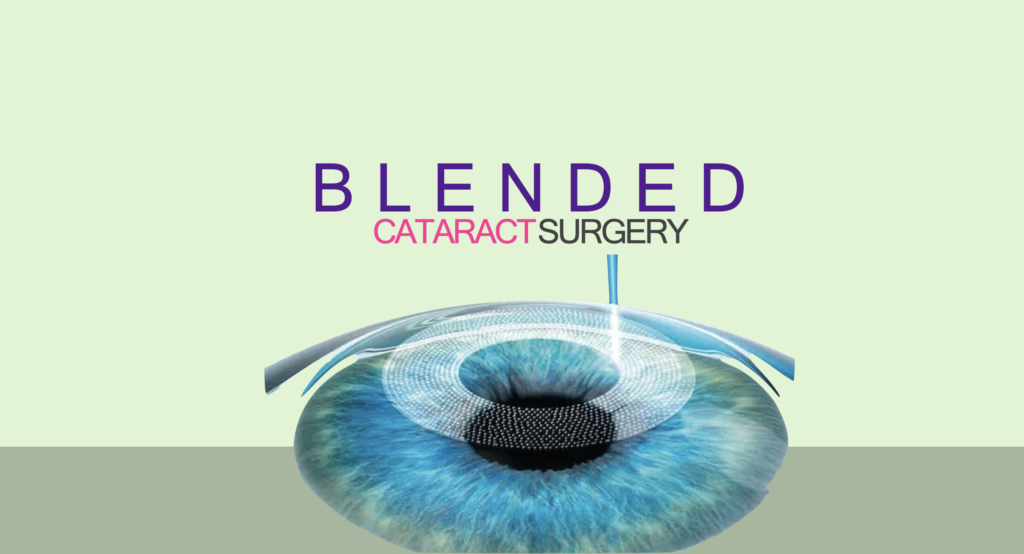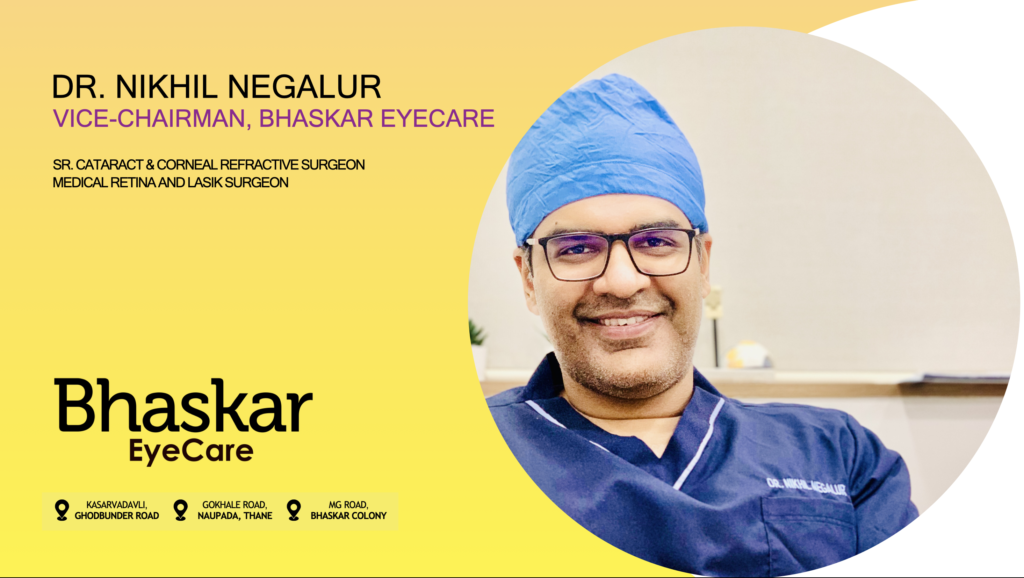Cataract Surgery is a procedure wherein your opaque lens is replaced by an artificial intraocular lens so that light entering the eye falls on the retina and a clear image is formed, allowing the patient to once again see clearly. Since the advent of Phacoemulsification technology, other laser based platforms, like Zeptosecond and Femtosecond lasers, have been developed successfully enabling surgeons to provide increasingly accurate surgical outcomes with lesser complication rates post cataract surgery.
Lens technology has also seen a major advancement in the past few years. We not only have the monofocal or single focus intraocular lenses but now, we also have bifocal, trifocal, quadfocal lenses which allow light to be focused for distance, intermediate and near vision. There has been further upgradation in the way light is focused on the retina with these multifocal lenses. This has led to lenses having extended depth of focus to create a “corridor of vision” on the retina. Lenses achieve this “corridor” by various technologies, such as, concentric ring design lenses, positive and negative spherical aberration inducing lenses and/or a combination of the two.
This technology advancement has, however, led to a massive confusion among patients as they have too many choices and decision making has become more difficult. At the time of choosing the type of lens, the patient is unsure of the final vision outcomes which a lens is capable of providing and many-a-times, a wrong selection is made leading to unhappy and stressful postoperative outcomes.
In our surgical practice, we try to provide our patients with options best suited for their requirements keeping in mind the limitations and benefits accompanying each type of lens. This also lets them know exactly what they should be prepared to expect post-surgery. In our premium cataract surgery experience over the past 1,00,000 patients operated in the past 7+ years, we have finalised and perfected two types of cataract surgical planning systems which help us deliver visual outcomes to our patient’s complete satisfaction. They are:
- Customized Cataract Surgery
- Blended Cataract Surgery

Customized Cataract surgery:
Developed with complete visual correction in mind, Customized Cataract Surgery is a very advanced planning system wherein, the patient’s complete visual system is studied and measured using over 2.5 lakh data points. A series of pre-operative criteria are checked which are critical to the adjustments needed for calibrating the visual system.
The idea is to provide outcomes where the distance, intermediate and near vision is clear. This is achieved by using lenses which have specific design elements which sharply focus incoming light at these distances. Ring-design multifocal lenses provide excellent distance, near and intermediate vision and are usually used for customized cataract surgery as long as the particular lens matches all the eye dimensions. This is paired with smaller incision sizes and the most advanced laser-based surgical systems.
Who should opt for Customized cataract surgery?
Patients who want uncompromised near vision should opt for this type of surgery. This approach allows mainly for excellent distance and near vision. Intermediate vision which is usually used for laptops, computers, cooking and art work are also covered satisfactorily if the patient so chooses. We usually suggest this option for people who need good near and intermediate vision after cataract surgery.
Are there any negatives with this visual system?
Unfortunately, YES! Ring-designed lenses usually are based on the principle of light division. That means, light which enters the eye is usually divided into the distance, intermediate and near components. This leads to different light allocation for different distances and in doing so, some of the light component is lost. Hence, people who require good contrast for their work eg. painters and artists, do feel some discomfort. Night driving is usually a common complaint seen with customization. The ring-design of the lens does produce a minimal “halo” effect around point sources of light which might be disturbing for some patients. However, neuroadaptation is very good for most of the modern lens designs and these complaints usually reduce or disappear within 6 months. These high performance lenses are also costly as compared to monofocals or basic bifocal lenses and the cost of surgery, therefore, is high.
Inspite of these minor negatives, Customized cataract surgery is the best option for near, intermediate and distance vision and spectacle independence can truly be achieve in most individuals. Lens advancements in design and materials in the past 5 years, has made this an attractive choice for people who want to be independent of reading glasses and want to carry out their daily activities without bothering about spectacles. Customization also uses some of the most advanced laser based surgical suites and state-of-the art measurement and calibration systems making it the most advanced offering in cataract surgery today.

What is Blended Vision and what changes with this surgical system?
Blended vision relies mainly on the concept of micro-monovision.
In traditional micro-monovision, one eye is designated for near vision and the dominant eye for distance vision. This system is designed around the concept that the overlapping optical calibrations will produce a “Hybrid” optical system which covers the whole spectrum. There were some pitfalls in these earlier assumptions and its effect was not reproducible among patients.
The Modern day Blended vision system uses lenses which have a longer “cone” or depth of focus. When these lenses are calibrated correctly, it produces an overlap which is more than 80% between the two eyes which allow excellent reproducibility and accuracy and reduces spectacle dependance by upto 95%. With state-of-the-art laser based surgical systems and this new category of lenses, blended cataract surgery has gained a huge momentum among patients.
What are the benefits of Blended Cataract surgery?
The main benefit of this system is the continuous and seamless focus achieved in the optical system. This is able to provide excellent distance and intermediate vision to patients and satisfactory near vision when needed. It is considered a more naturally adapted system as opposed to customised cataract surgery especially in older age groups. These lenses do not have have a traditional ring-based design but rather rely on induced aberrations on the lens surface to achieve “Extended for Stretched” optical capabilities. These lenses are superior for night driving as no or minimal “halos” are noted. Contrast loss is also minimal and is comparable to the monofocal lenses.
What’s not so good in Blended cataract surgery?
Near vision is not as good as with the customised cataract surgery option. This is especially seen in smaller font sizes and longer durations of reading. People who want excellent near vision should be aware of this aspect before selecting this surgical system. Although practically we see most of our patients don’t use reading glasses at all even with the Blended system, we need to acknowledge the limitations of this system.
So what to do?
Patients who are planning their surgery, need to have a detailed discussion with their doctor about the various options available to them. What is offered usually depends upon the surgical suite operational at the medical center and the surgeon’s experience with premium and high-performance lenses.
I usually recommend the type of surgery based on the patient’s expectations and the measurement profile of the eye. Customized cataract surgery is still the most accurate system to offer patients who want excellent near vision and require high precision vision for their daily actitvites. Blended vision usually is a more adaptable system providing excellent distance vision and good functional vision at all other distances. Blended vision can also be about 60% cheaper than the customized option at times.
In conclusion, patients can now opt for either spectacle independence or spectacle freedom. Selection of the surgical system depends on a number of variables and patient expectation. Understanding these different and complex systems can provide unmatched visual satisfaction.
About the author:
Dr. Nikhil Negalur is a senior Cataract & refractive surgeon at Bhaskar EyeCare practising in Thane. He is instrumental in designing the surgical system for Customized cataract surgery and has now developed the Blended vision surgical system. He mainly practises performance based advanced cataract surgery and corneal refractive surgery such as PRK, Contura-LASIK and SMILE.

To read his full profile, Click here.
